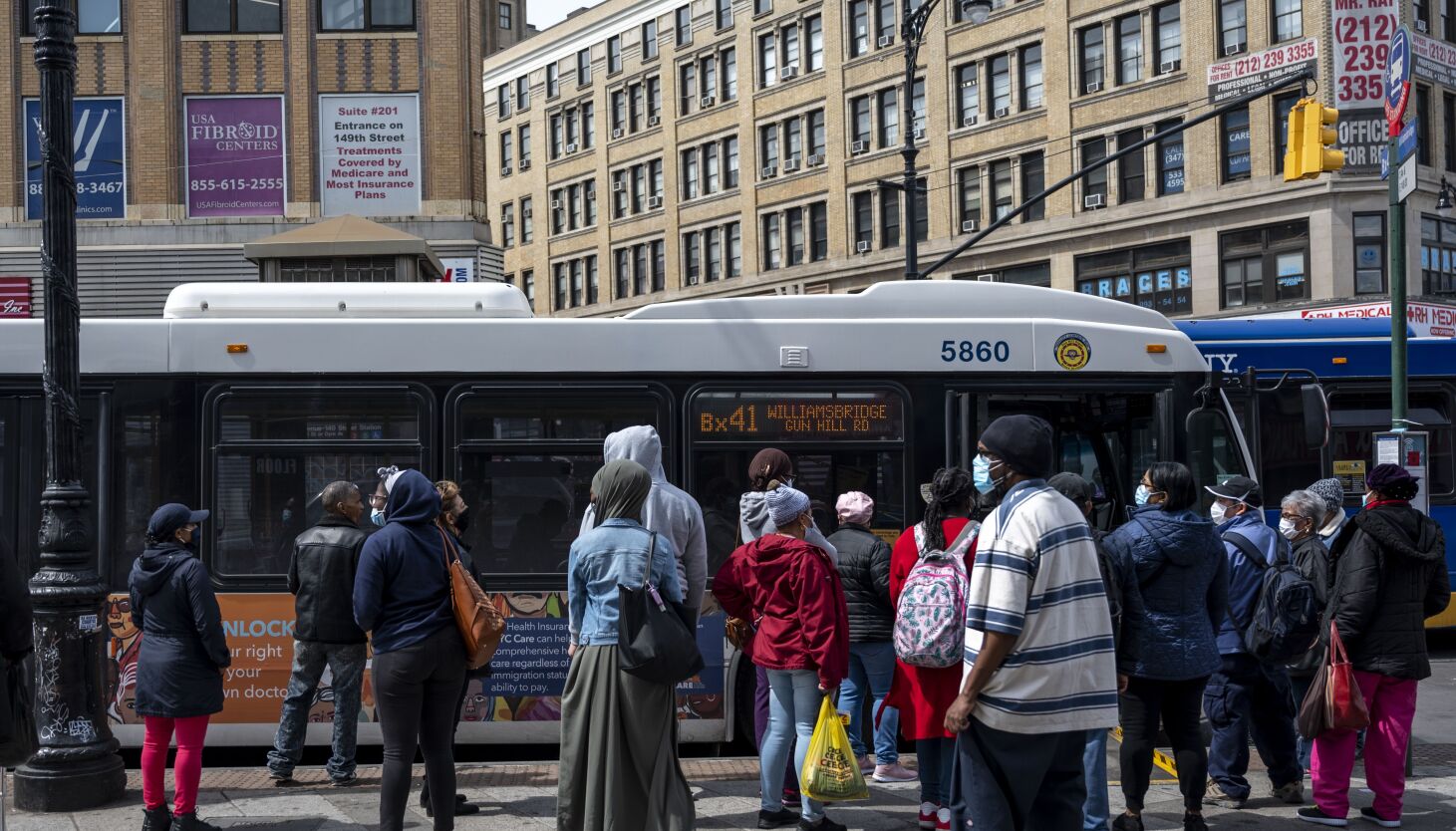As other cities experiment with fare-free transit, some MTA board members are calling on elected officials to come up with new funding sources that would allow the financially strapped agency to let New Yorkers ride buses for free.
The push comes as the Council of the District of Columbia voted last week to do away with Metrobus fares in Washington starting in July, and as Boston last year tapped into $8 million in federal pandemic relief money to eliminate fares on three Massachusetts Bay Transportation Authority bus routes through at least 2024.
While MTA officials have warned that higher-than-expected fare hikes may be needed by 2025 if ridership does not return to pre-pandemic levels, others say the time is now for mass transit to be funded similarly to the police, fire and sanitation services that are usually deemed “essential.”
“Not only do I think it’s not a pipe dream, it’s a necessity in post-COVID New York,” John Samuelsen, international president of the Transport Workers Union and an MTA board member, told THE CITY. “What are they going to do, keep raising the fare until they ice out the people they want to use the transit system?”
The union head tweeted last week that transit service should be built into the tax base, noting that “We don’t pay cops or firefighters per use and our children don’t pay to enter schools” and adding, “We need safe, reliable Mass Transit with no fare” along with a thumbs-up emoji.
Other sources have told THE CITY there are rumblings from Albany on legislative proposals for fare-free bus service.
New Funding Needed
An MTA spokesperson declined to comment for this story, but CEO and chairperson Janno Lieber has repeatedly called for transit to be funded as an essential service, saying that Washington, Albany and City Hall must find ways to help North America’s largest mass transit system get through its latest fiscal crisis.
At last week’s agency board meeting, Lieber said a discussion about new forms of funding “needs to unfold sooner rather than later.”
“Our recommendation is not to kick the can, to careen 100 miles an hour toward the fiscal cliff,” Lieber said after the Nov. 30 board meeting, “but rather to come up with a plan now that makes sure that the riders can count on the system being there at a high level of service, at an affordable cost.”
MTA Board Member David R. Jones, who is also president and CEO of the nonprofit Community Service Society — which was instrumental in the creation of the “Fair Fares” program that provides low-income New Yorkers with a 50% discount on subway and bus rides — noted that side benefits to fare-free transit could include enticing people onto mass transit and out of more expensive forms of transportation, such as for-hire vehicles.
But while fare-free transit is “politically attractive,” Jones said, it’s also “risky.”
“It would be a progressive step for the city,” he told THE CITY. “But the devil is in the details: how do you fund it?”
Samuelsen, Jones and others concede that the idea of free bus rides could become a reality only if federal, state and city elected officials come up with alternatives for funding a transit system whose farebox revenues have been clobbered by the pandemic — yet service frequency and quality must not decrease.
The MTA did suspend fare collection on local bus routes and shifted to rear-door boarding in March 2020 to lessen bus operators’ exposure to COVID-19. Collection resumed in August of that year, but the agency has continued to struggle with fare evasion: THE CITY reported that more than 50% of all bus riders in The Bronx hop on for free, compared with 40% on Staten Island, 30% on Manhattan and Brooklyn buses and 15% in Queens.
“I see people get on the bus all the time without paying, so it’s already free for them,” said Jennifer Saura, 30. She spoke to THE CITY in Spanish while waiting on Wednesday for a Bx2 bus on East 149th Street in The Bronx. “That can be frustrating for those who always pay the fare,” Saura said.
World-Class Idea?
Globally, fare-free transit has been launched in Dunkirk, France and Tallinn, Estonia, along with dozens of “mostly small” cities and towns, according to a 2019 report by the nonprofit TransitCenter.
Robert Puentes, president and CEO of the Eno Center for Transportation, a think tank in Washington, acknowledged that implementing fare-free transit is a trickier proposition for larger systems like the MTA, which traditionally has had a higher reliance on farebox revenue.
“It’s an easier conversation to have in a mid-sized or smaller city rather than the nation’s undisputed transit leader,” Puentes told THE CITY. “In a place like New York, with a larger share of farebox recovery ratio, you’ve got to make it up somewhere.”
Central to the concept is that buses’ quality of service cannot slip if they become fare-free, he said, especially because they are so important to lower-income riders.
“The case is clear that you can’t make it free and then provide substandard service,” Puentes said. “That’s not fair, that’s not optimal.”
New York has struggled to enroll people in the city-funded Fair Fares program that offers half-priced MetroCards to low-income riders. Streetsblog reported in October that Fair Fares usage has inched up 14% to 276,814 people since its 2019 launch, even after MTA officials had pledged last year to work with the city to double enrollment.
“It clearly hasn’t been advertised enough,” Jones said. “Large numbers of people who would be eligible don’t know about it.”
While eliminating the enrollment hurdles of the discounted rides program, moving to 100% fare-free transit would present another series of challenges.
David Bragdon, executive director of TransitCenter, pointed to how Kansas City was hailed in 2019 when leaders voted to make it the first major U.S. city to approve free transit through the three-year ZeroFareKC program, but said service has remained unreliable.
“Kansas City got headlines for removing the fare from transit,” Bragdon told THE CITY. “The only difference is that they took bad transit that cost $1.50 to ride and now they have bad transit that is free to ride and therefore, few people ride it.”
‘We Should Seize the Moment’
The MTA is facing what has often been called a “fiscal cliff” as the agency uses up $15 billion in emergency federal aid to support operations during the pandemic, a sum officials have said could be exhausted by 2024, a year earlier than originally projected.
Prior to the pandemic, the MTA had, for more than a decade, relied on revenue from fares and tolls to cover about 50% of its annual operating budget. But with ridership still far below 2019 levels, transit agency leaders have been calling for new ways to fund a system that now faces the prospect of farebox revenue of around 35% for several years, according to MTA documents.
“It’s painstakingly clear that the way they did business in terms of revenue generation can’t work anymore,” Samuelsen said. “They’ve had their asses burned by it.”
JP Patafio, a TWU Local 100 official who has been touting free transit for two years, called it “an idea whose time has come.”
“With COVID, the environment and the economy, fare-free local bus service is the low-hanging fruit of public transportation,” Patafio said. “We should seize the moment.”
Jones, the MTA board member, said the idea seems more viable now, given what is taking place in Boston and Washington.
“The fact that other cities are picking it up is important,” he said. “It provides some legitimacy to the idea to at least explore it.”




